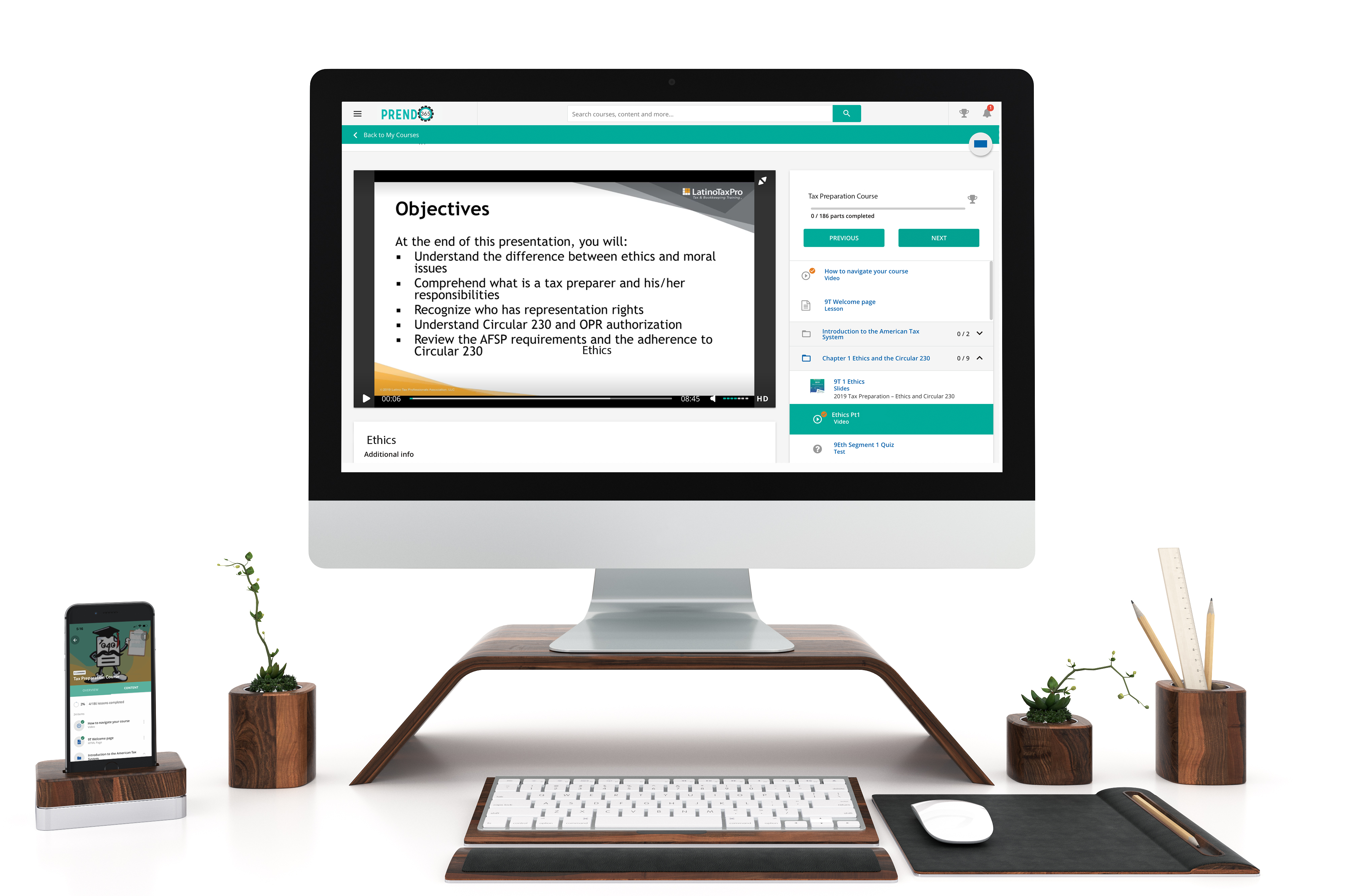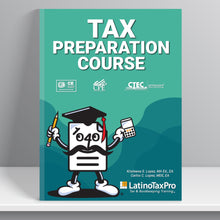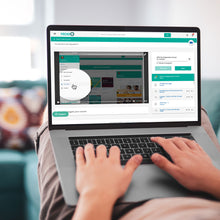In this beginner tax preparer course, you will learn…
- How to prepare a federal individual tax return
- Filing status
- Which form to use
- The importance of safeguarding the taxpayer’s documents
- When to use Form 4868.
- The different e-filing options.
- How to complete Schedule 2 of Form 1040.
- How a nonrefundable credit affects the taxpayer’s tax liability.
- Which deductions are limited to the 7.5% floor.
Our proprietary Professional Training System, Prendo365.com, combines traditional textbook courses with online interactive questions and Practice Tax Returns (PTR). Each chapter in the course is the foundation for the next. After each chapter, the student will complete a PTR and review questions.
PTRs are in PDF format and include links to the necessary forms to complete a tax return by hand. The PTRs will have their own set of review questions which are based on the material covered in the chapter. Español? Click here.
Click on a chapter title to view the content description
Chapter 1: Ethics and Preparer Penalties
This chapter will cover tax preparer due diligence and penalties. When the taxpayer files a return with refundable credits the tax preparer needs to complete an accurate tax return and complete Form 8867, which is attached to the taxpayer’s return. The following refundable credits will be discussed in this course:
- Earned Income Credit (EIC).
- Child Tax Credit (CTC).
- Additional Child Tax Credit (ACTC).
- Other Dependent Credit (ODC).
- American Opportunity Tax Credit (AOTC).
Chapter 2: Compiling Taxpayer Information
The tax preparer will learn how to collect taxpayer’s information needed to prepare an accurate tax return. This course will give detailed interviewing example questions to understand how to collect the necessary information. Completing an interview to gather taxpayer’s information to understand the taxpayer’s situation to prepare an accurate tax return is an essential step.
Sample questions are provided for each section of the tax return to help the student understand the importance of knowing the “how” to and “why” ask questions to gain the necessary information from the taxpayer.
Chapter 3: Filing Status, Dependents and Deductions
This chapter offers a review on who qualifies for the standard deduction, and what circumstances allow taxpayers to claim a higher standard deduction. You will also learn what an exemption is, (even though it has been suspended due to TCJA). Filing status is used to determine filing requirements, standard deduction, correct tax, and taxpayer’s eligibility for certain credits and deductions. If more than one filing status applies to the taxpayer, the tax professional should choose the one that lowers the amount of tax for the taxpayer.
Chapter 4: Income
The IRS has the authority to tax all income from whatever source derived. This includes compensation for services, gains from dispositions of property, interest and dividends, rent and royalties, pensions and annuities, gambling winnings, and even illegal activities. All such income a person receives is collectively referred to as “worldwide income.” However, not all money or property is taxable or subject to tax. This course discusses the different types of taxable and nontaxable income and show you where and how to report such wages on a professionally prepared tax return. A tax professional must recognize the different kinds of taxable income, tax-exempt income, and other income included in Schedule 1, line 8, and must know how to figure out the taxable percentage on social security benefits.Chapter 5: Adjustments to Income
In this chapter, students will learn how various expenses are used to “adjust” or lower the taxpayer’s income to arrive at his or her adjusted gross income (AGI). They will also learn how the Tax Cuts and Jobs Act (TCJA) has impacted adjustments at the federal level and how to handle any previous-year returns that preceded those TCJA-mandated changes.
Chapter 6: Other Taxes and Taxpayer Penalties
This chapter provides an overview of miscellaneous taxes from the Form 1040 and reported on Schedule 2 that a taxpayer might be assessed. This includes excess Social Security tax, additional taxes on IRAs, the Alternative Minimum Tax, and household employment taxes.
Chapter 7: Payments and Tax Credits
A nonrefundable tax credit reduces the amount of tax liability that may have to be paid. Unlike a deduction, which reduces the amount of income that is subject to taxation, a credit directly reduces the tax itself. There are two types of credits: nonrefundable, which cannot reduce tax liability below zero, and refundable, which can reduce tax liability below zero, resulting in the need for a refund.
Chapter 8: Itemized Deductions
When computing taxable income, personal expenses cannot be claimed as itemized deductions; however, tax rules do allow for some deductions that are essential for daily living. These specific expenses are deductible as itemized deductions. A standard deduction is a set amount that the taxpayer can claim based on his or her filing status. Itemized deductions are shown on the tax return using Schedule A, Itemized Deductions. The taxpayer must decide whether to itemize deductions or use the standard deduction and should choose whichever option is best for their tax situation.
Chapter 9: Schedule C
This chapter encompasses how the sole proprietor reports income. Sole proprietorship is the most popular business structure. A sole proprietorship is indistinguishable from its owner, and all income earned is reported by the owner. Schedule C is the reporting tool for most sole proprietors. Covered in the course is line by line instruction to complete the Schedule C.
Chapter 10: Schedule E and Capital Gains and Losses
Rental income is any payment received for the use or occupation of real estate or personal property. The payment that is received is taxable to the taxpayer and is generally reported on Schedule E. Each Schedule E can report three properties. If the taxpayer has more than three properties, additional Schedule E’s would be used. Schedule E is not used to report personal income and expenses. The taxpayer should not use Schedule E to report renting personal property, that is not a business. To report other income, use Schedule 1, lines 8 – 24b.
This chapter includes how to calculate a short term and/or long-term gain or loss. The student will understand holding period and what is a capital asset. Almost everything a taxpayer owns and uses for personal or investment purposes is a capital asset. When a capital asset is sold, the difference between the basis in the asset and the amount the item is sold for is either a capital gain or capital loss.
Chapter 11: Schedule F and Depreciation
Income received from the operation of a farm or from rental income from a farm is taxable. Farmers determine their taxable income from farming and related activities by using Schedule F. Profit or loss from farm income is first reported on Schedule F and then “flows” to Form 1040, Schedule 1, line 6. This course covers basic farm income and expenses.
Depreciation is an annual deduction that allows taxpayers to recover the cost or other basis of their business or investment property over a certain number of years. Depreciation is an allowance for the wear and tear, decline, or uselessness of a property and begins when a taxpayer places property in service for use in a trade or business. The property ceases to be depreciable when the taxpayer has fully recovered the property’s cost or other basis or when the property has been retired from service, whichever comes first. Depreciation is reported on Form 4562.
Chapter 12: Extensions and Amendments
If taxpayers are unable to file their federal individual tax returns by the due date, he or she may be able to qualify for an automatic six-month extension of time to file. The taxpayer can either electronically file or mail Form 4868 to the IRS to file for the extension. If the taxpayer has filed a return and realizes that a mistake was made, he or she would file an amended return by using Form 1040-X.
Chapter 13: Electronic Filing
Electronic filing (also referred to as E-File and E-filing) is the process of submitting tax returns over the internet via properly-certified tax software. The E-File system has made tax preparation significantly easier, and the IRS notifies software users within 24-48 hours if they accepted or rejected the tax return. E-filing is not available year-round but rather begins sometime in January and ends sometime in October; the IRS determines when exactly e-filing begins and ends each year, and states follow whatever dates the IRS sets. An electronic return originator (ERO) is the individual who originates the electronic submission of the tax return. To file a return electronically, the individual needs to be an Authorized IRS e-File Provider.
end
| Course Details | Included in this course |
|
To earn certificate of completion: • Pass Final with 70% (or better) |
• 13 Chapters (eBook) • Quizzes • Videos • Practice Tax Return • Practice Tax Return Final Exam • Federal Final Exam |

Self Study
Learn at your own pace, read or watch the lessons, pass the exams.
Mobile Friendly
Learn on your phone, tablet, or computer.
Bilingual
All our courses are available in English y español.
Career Paths
No matter where you’re at in your career, we have courses for you.
Simple Learner Experiences
Prendo365 gives you access to your course anytime, anywhere, on desktop, tablet, or mobile device. You're able to easily navigate through your course and receive your certificate of completion.
Why choose us
Over 35+ years tax preparation experience
We know what tax preparers need to succeed in their office
7+ EA’s and tax preparers on staff
Our team does extensive research to ensure you receive the best education
Bilingual live support
Having technical issues? We're ready to help you get started and complete your course.






